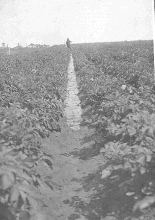
Irrigation is a term used to describe the process of watering farmland by diverting water from natural sources to designated areas. The diversion of water is developed and controlled within what is called an irrigation district. An irrigation district is responsible for maintaining a water supply to farmers in a certain area. This is accomplished by using a water source such as a river and diverting it through a system of dams, reservoirs, and canals that eventually deliver water right to the farmers' fields.
Irrigation is needed in areas like southern Alberta where the climate is arid or semi-arid and is characterized by low and unpredictable rainfall. Farming methods relying on only mother nature to provide water for crops is known as dry-land farming, and can still be very successful in such a climate. However, irrigation tends to increase farm production by improving crop yields and the ability to grow specialty crops not available to dry-land farming. In addition, other benefits such as population and economic growth are also a result of irrigation.
But there are problems associated with irrigation. Three of these problems are salinization, seepage and cost. Salinization is a result of a build up of salt in the soil and root zone which can hurt plant growth. Seepage occurs when nearby water reserves such as reservoirs or canals raise the water table. This can make the surrounding land too wet and soft, often resulting in making it difficult to till or seed the land. The cost for an irrigation system is also a problem. Irrigation farmers pay for their equipment, the cost for maintenance and energy to run the system. In addition, a cost is levied on the farmer by the irrigation district who provide for the water service. However, for most farmers the advantages to irrigation have outweighed the disadvantages. By 1986, a total of 747 625 hectares of farmland were irrigated in Canada. In that same year 466 291 hectares of that land were irrigated in Alberta.
In the past, irrigation construction and maintenance projects were funded by private individuals or corporations that wanted to see development on their land. Today, provincial and federal governments have cost sharing agreements for new irrigation development. This is mainly due to the high costs associated with irrigation development. The costs are affected by the limited supply of water resources and increasing global market competition in agriculture. The St. Mary River Irrigation District (S.M.R.I.D.) in southern Alberta near Lethbridge is one such project resulting from these cost sharing agreements. In fact, by 1986 the S.M.R.I.D. was Canada’s largest district which provided irrigation to over 132 600 hectares of land.

P19800207000-GM Flood irrigating sugar beets.
The irrigation season in southern Alberta generally runs from May to the end of September. Throughout this time farmers have access to the water provided to them through the irrigation systems canals. However, during long dry periods main district reservoirs may be down if natural water sources are low. This may force an irrigation district to shut down for a period of time to build up its reservoirs, at the same time leaving the farmers without water as the canals quickly dry up. On the other hand, excess rainfall may allow for the farmer to not have to irrigate.
There are basically four types of irrigation methods available to farmers in southern Alberta. These four types of irrigation are called flood, hand move, wheel move, and pivot. Flood irrigation is the process of opening up pipes or canals that actually result in flooding the crop with a few inches of water. This soaks the ground and provides water to plants in the soil. Hand move irrigation consists of a number of connected pipes that have built in sprinklers which are laid down on the crop to irrigate. The term “hand move” is derived from the fact that the farmer is required to move the pipes manually in order to irrigate different areas of the crop. Wheel move irrigation consists of one long section of pipe that is attached to wheels that are located at periodic intervals along the pipe. At the center of the section of pipe is a gas motor that makes the wheels rotate and thereby moves the entire section or pipe forward. Over time the wheel move will travel from one side of the field to the other while irrigating. Pivot irrigation works on a similar basis as wheel move except the section of pipe moves or “pivots” in a circle like the hour or minute hand of a clock. This allows the system to continually irrigate without the need to control how far it will go in one direction like the wheel move method.
Previous Page | Exhibit Contents | Home | Navigation Information | Glossary | Curriculum Guide | Next Page
Copyright © 1996 Sir Alexander Galt Museum. All rights reserved.